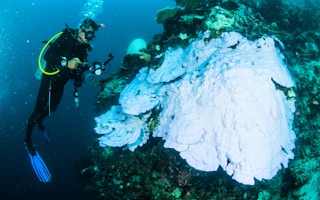Record sea temperatures combined with a strong El Niño are causing widespread coral bleaching, which is threatening to kill over 12,000 square kilometres of reefs.
The US National Oceanic and Atmospheric Administration (NOAA) has declared a global bleaching event, making this only the third such crisis in recorded history.
NOAA’s declaration has implications for the livelihoods of 500 million people worldwide and income worth $30 billion, because reefs support 25 per cent of all marine species and are a nursery ground for many species of fish.
The bleaching is directly connected to climate change: it is the warmer water that causes the problem. The first global bleaching event was in 1998 and the second in 2010, both in years marked by El Niños, the periodic climate phenomenon in the Pacific.
Each time the potential for damage has been greater because the sea has been warmer before the start of the El Niño. This August the ocean was the warmest on record – and this time NOAA’s estimate is that 38 per cent of the world’s reefs may be affected.
Huge losses
Coral bleaching this year began in the Florida Keys and South Florida in August. Record bleaching is now taking place in Hawaii; it is spreading to the Caribbean and may last until the New Year.
“
The coral bleaching and disease brought on by climate change, and coupled with events like the current El Niño, are the largest and most pervasive threats to coral reefs around the world.
Mark Eakin, NOAA’s Coral Reef Watch coordinator
As the exceptionally warm water spreads across the Pacific the bleaching event is expected to hit the Great Barrier Reef in Australia in early 2016, causing more damage, some of it permanent.
Mark Eakin, NOAA’s Coral Reef Watch coordinator, said: “The coral bleaching and disease brought on by climate change, and coupled with events like the current El Niño, are the largest and most pervasive threats to coral reefs around the world.
“As a result, we are losing huge areas of coral across the US, as well as internationally. What really has us concerned is this event has been going on for more than a year and our preliminary model projections indicate it’s likely to last well into 2016.”
Corals live in symbiosis with algae, and the two creatures depend on each other for survival. The apparent bleaching happens because as sea temperatures rise above coral comfort levels, the increasingly stressed corals and the colourful algae part company.
Protection lost
As a result, the corals whiten, lose their source of nutrients and – if the bleaching goes on for too long – will die.
Minor bleaching can be repaired and reefs recover, but at high temperatures and on this scale large areas can die. Apart from the loss of the corals, damage to the tourist industry and fishing, it also increases flood risk, because healthy reefs act as a storm barrier for many islands and low-lying coasts.
Graphic illustrations of bleaching can be seen on a website set up to alert people to the dangers and record the event.
There is particular concern on Hawaii at the moment. It suffered bad bleaching in 2014, which is currently getting worse.
Record warming
Eakin said the bleaching was a crisis. “Hawaii is getting hit with the worst coral bleaching they have ever seen, right now. It’s severe. It’s extensive. And it’s on all the islands.
“In one part of northwestern Hawaii the reef just completely bleached and all of the coral is dead and covered with scuzzy algae.”
The bleaching has also struck Cuba, Haiti and the Dominican Republic and is about to hit Puerto Rico and the Virgin Islands, he said. Oceans worldwide are by far the warmest on record – August 2015 was two-fifths of a degree warmer than August 1998. Eakin said: “Next year may be as bad as this year or even worse.”
Gregor Hodgson, who heads the group Reef Check Australia, is concerned about the forecast that the warm blob of water caused by El Niño will hit the country’s Great Barrier Reef early next year.
The reef is the planet’s biggest, a world heritage site and a magnet for tourists. The computer model forecasts “this horrendous, dramatic” impact on the reef, Hodgson said. “It’s truly terrifying.”










